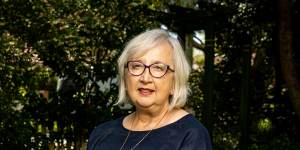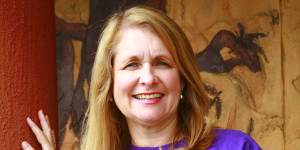Anna was in year 5 at after-school care when she first watched adults having sex. A boy looked it up on shared iPads and showed her. She didn’t alert an adult because she was scared “we’d get the iPad taken away,” remembers Anna*,who is now 16. “I thought from then on,that’s the kind of thing everyone looks at.”
Like Anna,Jane’s first encounter with pornography was also accidental. A boy at school was showing it to other kids. “It was confronting,” she says. Another girl,Kate,was in primary school too,watching videos on her laptop when a clip of adults having sex popped up with no warning. “I remember being really scared of it,” she says. “I didn’t want to open my laptop again.”
Like many Australian children,their early exposure to adult material was accidental,before they reached puberty. But when they began high school,aged 12,it increased rapidly. “The boys were talking about it,” says Anna,speaking to this masthead with her parents’ permission. “You’d hear about it from older people at school.” Says Kate:“The guys would often show me what porn they were watching. And that’s when I started to be,like,‘that’s what I’m meant to be doing’.”

How can access be restricted?
Australia will soon embark on a debate about whether the government should step in to restrict children’s access to online pornography;the eSafety commissioner has given its road map to Communications Minister Michelle Rowland,who is due to respond soon.
The debate will be fraught,as it’s complicated by privacy (particularly adults’ fears about their own porn use being exposed),decades-old standoffs about the harms or otherwise of pornography itself,and technical questions about how it can be done without pushing it underground or punishing the local adult industry.

Examples of violent pornography easily accessed on the internet.Supplied
There are different types of age verification,ranging from a system in which a user supplies their official ID to get a verification code to one in which face analysis technology analyses a user’s facial characteristics to estimate their age. Some think a government agency should keep any data;some say the sites themselves should take responsibility;and some say parents should be the ones responsible for policing their kids’ internet use.
Under the United Kingdom’s latest proposal,any companies that failed to introduce age checks to the regulator’s standard on adult websites would face fines worth up to 10 per cent of their global turnover and could have their services blocked in the UK. The French “porn passport” plan involves users installing a government app on their phone that would give over-18s a certificate known as a porn passport,and a code to access websites.
When Louisiana in the US introduced the laws for sexually explicit sites in the middle of last year – users had to obtain a code from a government app – Pornhub’s traffic sank. Earlier this month,the adult site retaliated against new laws in Utah by blocking its content to the whole state,warning age verification “would put children and your privacy at risk”. In the US,some states are looking at similar age-gating for social media sites.
Why we need to act
National Children’s Commissioner Anne Hollonds acknowledged the privacy challenges but said some of the opposition would come from businesses that had been profiting from unregulated access. “They don’t want any breaks on their ability to run their businesses,” she said. “We’ve allowed this to develop in a wild west kind of way,and now we’re having to retrofit. People don’t like that. But it’s extremely important,in my view,that we do.
“Emerging research is showing that kids,especially young boys,are being exposed to this material at ages eight or nine,in higher numbers than anyone could have possibly imagined. We’re spending lots of money on addressing the outcomes of that later in life – and there are outcomes from early exposure to the material – and we’re never going to fix it unless we act earlier to use the levers we have to ensure children are protected.”

National Children’s Commissioner Anne Hollonds.Ben Symons
When Australia’s eSafety commissioner developed the road map,it consulted everyone from international adult website providers and the local industry to educators and youth advocates. It has acknowledged that any action needs to balance privacy and safety,and include education and awareness.
Some it consulted (international adult websites) were concerned age verification would push people to darker sites as well as hurt business,and argued sex education was a better approach. Some (pro-porn academics) said restricting access could impact the business of sex workers,and warned a crackdown could entrench “heteronormative,ableist and kinkphobic assumptions about behaviour”.
There were also questions about whether any new laws would encompass Twitter and Reddit,social media sites that are also used to share adult material (internal documents obtained by Reuters suggested 13 per cent of content on Twitter was pornographic).
Age verification options
Source:Age Verification Providers Association
Others (youth advocacy and wellbeing groups) said the road map should consider the different impact at different ages;for example,what was appropriate for a 15 or 16-year-old was different to what was suitable for 10 or 11-year-olds. They argued that while parental controls were useful,they would not be sufficient because they already existed and had not been effective.
Teachers told the commissioner about an increase in peers sharing pornography in school environments such as on the school bus and on laptops in class,and said many adults were unaware of the kind of content available online. Technology providers warned there was no silver bullet;all measures could be circumvented.

Holly-Ann Martin of Safe4Kids,a child safety organisation.Supplied
There was wide concern about the collection of data – especially if official ID was required – and many of those consulted said the model should minimise the amount of data it collects to protect privacy,pointing out that it’s the age that’s important,not the identity. It could be stored by a third party,such as the government.
Holly-Ann Martin,who runs child safety organisation Safe4Kids,backed age verification but said parents still needed to be active.
“I had a class of 24 seven-year-olds and,at the end,eight of them stayed behind to say they’d seen something on[online] but not one had told their parents,” she said. “They said the picture still pops into their head and ‘makes us feel yuck’. Kids think dad’s doing that to mum”. Martin was “all for age verification,but it’s not going to stop everything. It’s Pandora’s Box,you can’t shut it”.

Tama Leaver,a professor of internet studies at Curtin University in Perth,said an age verification system that required the provision of government-issued ID would be the worst option for Australia,due to trust and privacy issues. However,a system that allowed a user to provide an immediately deleted selfie for age analysis “doesn’t seem unreasonable”,he said.
“I do have some faith that this government is trying to get a good balance. I don’t think we’ll get a perfect answer;if it’s a careful process,the government could find a better balance than ‘enter your birthdate’. A better balance than the one we’ve got now is not hard to imagine;at the moment,it’s ‘enter a random year and we just take you on faith it’s true’.”
Michael Salter,an associate professor in criminology at the University of NSW,backed age verification of adult content,saying there are entire genres that cannot be justified,such as incest content. “We know that child sex offenders use pornography to normalise their abuse of children,” he said. “What do you think incest offenders are doing with this genre of pornography? They are showing it to their victims.”
He called for adult content to be regulated in the same way as other media content. “[Such as],you cannot depict sexual acts between family members,” he said. “You cannot depict rape. This is an extremely low bar for the adult industry to meet.

Sunroom co-founder Michelle Battersby.Louie Douvis
“We don’t all have to agree on the moral or political status of pornography to move forward with perfectly sensible,practical measures.”
Mish Pony from the Scarlett Alliance,the peak body for sex workers,said age verification was not feasible. It could drag in non-harmful material,such as sexual health resources,and the storage of data would also concern users (overseas,age gates have been calibrated to exclude health information). “There’s risk of hacking or data leaks where someone – a bad actor – is able to access your pornography viewing history,” they said.
In online safety debates,“sex workers are collateral damage,” Pony said,“in that sex worker spaces for communication and safely sharing are shut down,or sex worker advertising is shut down.”
However,Michelle Battersby,the founder of Sunroom,a platform for adult content created by women (including trans and non-binary people),said she was not worried about age verification as the company already had measures in place.
“If anything,centralised governance of age verification for technology platforms would be hugely beneficial for us (if implemented well) as age verification when joining any platform would become conventional and frictionless,and our users wouldn’t be deterred when asked for this information,” she said.
Iain Corby from the UK’s Age Verification Providers Association said the British legislation has taken longer than expected because former prime minister Boris Johnson did not want any controversy overshadowing the general election.
“The tech was ready;leading porn sites were prepared and willing to comply;there was no new risk to privacy for users;and the narrow scope ... was understood as a starting point which would be extended,” Corby said.
What teens have to say
Adult views will dominate this debate. But teens also have opinions. When this masthead sat down with four adolescents – all female,all 16,and all either hetero or bisexual – with their parents’ permission,they pointed out that teens have always been curious about sex,and how to do it. In an age of video tutorials for everything from smokey eye makeup application to installing a tap,many use pornography as a way to educate themselves.
“I feel like everyone’s kind of had a point where they’ve Googled,what is it?” said one. “How is it supposed to look? How is it supposed to feel? How am I,as a person,supposed to be while I’m having sex with someone? Porn shows people being so rough,guys would get so confused by that,and go,‘we’re supposed to do those movements. Am I supposed to do things like,hold her down?’.”

They believe sex education needs to be more expansive and directly tackle once-taboo topics such as what sex should feel like,what an unhealthy power dynamic in a sexual relationship looks like,and how to tell the difference between unrealistic and ethical pornography. They cite British TV showSex Education,about a high school boy who becomes an unofficial sex and relationship therapist,as a model of how to broach the subject in an unselfconscious way.
“Jane” has been approached for sexual pictures,despite warnings about this at school. “Do you send?” is a common proposition,she said,which is sometimes accompanied by a plea;“You don’t love me if you don’t do this.”
“Emma” said:“If you said,oh,I’m not really into anything,they’d be like,‘you have to be into something,you’re so vanilla[a slur]’.”
Said another:“Girls are not being looked after. Boys are not being given the education about what they’re doing online,that porn is not an accurate representation of what sex is,and how to treat their partner. We should also be taught that sex can be amazing,and not just,‘you’re not 16 yet,you shouldn’t be having sex’. We should be learning how to do it safely,consensually,pleasurably.”
Pseudonyms were used to protect the teenagers’ identities.